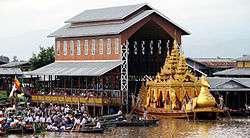Yawnghwe
| Yawnghwe ယွင်ႈႁူၺ်ႈ | |||||
| Princely State of the Shan States | |||||
| |||||
 | |||||
| Historical era | British Raj | ||||
| • | Foundation of the city of Yawnghwe | 1359 | |||
| • | Abdication of the last Saopha | 1959 | |||
| Area | |||||
| • | 1901 | 2,241 km2 (865 sq mi) | |||
| Population | |||||
| • | 1901 | 95,339 | |||
| Density | 42.5 /km2 (110.2 /sq mi) | ||||

Yawnghwe (Shan: ယွင်ႈႁူၺ်ႈ), known as Nyaungshwe Burmese: ညောင်ရွှေ) in Burmese, was a Shan state in what is today Myanmar. It was one of the most important of the Southern Shan States. Yawnghwe state included the Inle Lake. The administrative capital was Taunggyi, located in the northern part of the state. The Agent of the British government, the Superintendent of the Southern Shan States, resided at Taunggyi and the king's palace was at Yawnghwe.[1]
History
According to tradition in very distant antiquity there was a predecessor state in the area named Kambosarattha. The city of Yawnghwe, which gave name to the state, was founded in 1359 by two mythical brothers, Nga Taung and Nga Naung, who arrived from Tavoy (Dawei) and were allowed to build a capital by a prince who ruled the region. The brothers brought 36 families from Tavoy and established themselves in the new city. Yawnghwe included the subsidiary states of Mawnang (Heho), Mawson, Loimaw, Loi-ai and Namhkai. Historically the majority of the population in the state belonged to the Intha, Pa-O, Danu, Shan and Taungyo people groups.
The state of Yawnghwe formally accepted the status of British protectorate in 1887.[2]
Sao Shwe Thaik was the first president of the Union of Burma and the last Saopha of Yawnghwe he married Sao Nang Hearn Kham of the royal family of North Hsenwi. His residence in Yawnghwe town, the Haw, is now the "Buddha museum" and is open to the public.
Rulers
The rulers of Yawnghwe bore the title of Saopha; their ritual style was Kambawsarahta Thiri Pawaramahawuntha Thudamaraza.[3] They were entitled to a 9-gun salute by the British authorities.[4]
Saophas
- 1695 - 1733 Hkam Leng
- 1733 - 1737 Htawk Sha Sa
- 1737 - 1746 Hsi Ton Sa
- 1746 - 1758 Hke Hsa Wa
- 1758 Naw Mong I
- 1758 - 1761 Yawt Hkam
- 1761 - 1762 Hpong Hpa Ka-sa
- 1762 - 1815 Sao Yun
- 1815 - 1818 Sao Se U I
- 1818 - 1821 Naw Mong II
- 1821 - 1852 Sao Se U II
- 1852 - 1858 Sao Se Hom (d. 1858)
- 1858 - 1864 Sao Naw Hpa
- 23 Oct 1864 - 1885 Sao Maung (1st time) (b. 1848 - d. 1927)
- 1886 - 1897 Sao Ohn
- 1897 - Dec 1926 Sao Maung (2nd time) (s.a.) (from 19.., Sir Sao Maung)
- Sep 1927 - 1952 Sao Shwe Thaik (b. 1896 - d. 1962)
Traditional royal ceremonies
Formerly the Saopha of Yawnghwe would personally welcome the four Buddha images during the annual festival at Hpaung Daw U Pagoda, an 18-day pagoda festival, during which the Buddha images were placed on a replica of a royal barge designed as a hintha bird and taken in a procession throughout Inle Lake. The elaborately decorated barge was towed by several boats of leg-rowers rowing in unison together with other accompanying boats. The images would be taken from the royal barge and a grand procession would take them to the palace or haw of the Saopha, entering the prayer hall from the eastern entrance, where the images would be kept for a few hours.[5]
Nowadays the festival is still held, but the images bypass the visit to the haw and are taken directly to the temple.
See also
References
- ↑ "WHKMLA : History of the Shan States". 18 May 2010. Retrieved 21 December 2010.
- ↑ Imperial Gazetteer of India, v. 24, p. 415.
- ↑ Ben Cahoon (2000). "World Statesmen.org: Shan and Karenni States of Burma". Retrieved 7 July 2014.
- ↑ Yawnghwe (Shan State) (9 Gun Salute)
- ↑ History of Shan Churches in Burma 1861-2001
External links
 Media related to Yawnghwe at Wikimedia Commons
Media related to Yawnghwe at Wikimedia Commons- "Gazetteer of Upper Burma and the Shan states"
- The Imperial Gazetteer of India
Coordinates: 20°39′N 96°56′E / 20.650°N 96.933°E